Banning Single Use Plastics to Reduce Terrestrial and Marine Pollution and Greenhouse Emissions
VerifiedAdded on 2022/11/18
|9
|2290
|386
AI Summary
This paper examines the effectiveness of banning single-use plastic materials as a response to the rising ocean pollution endangering marine life and greenhouse gas emissions from plastic manufacturing industries.
Contribute Materials
Your contribution can guide someone’s learning journey. Share your
documents today.
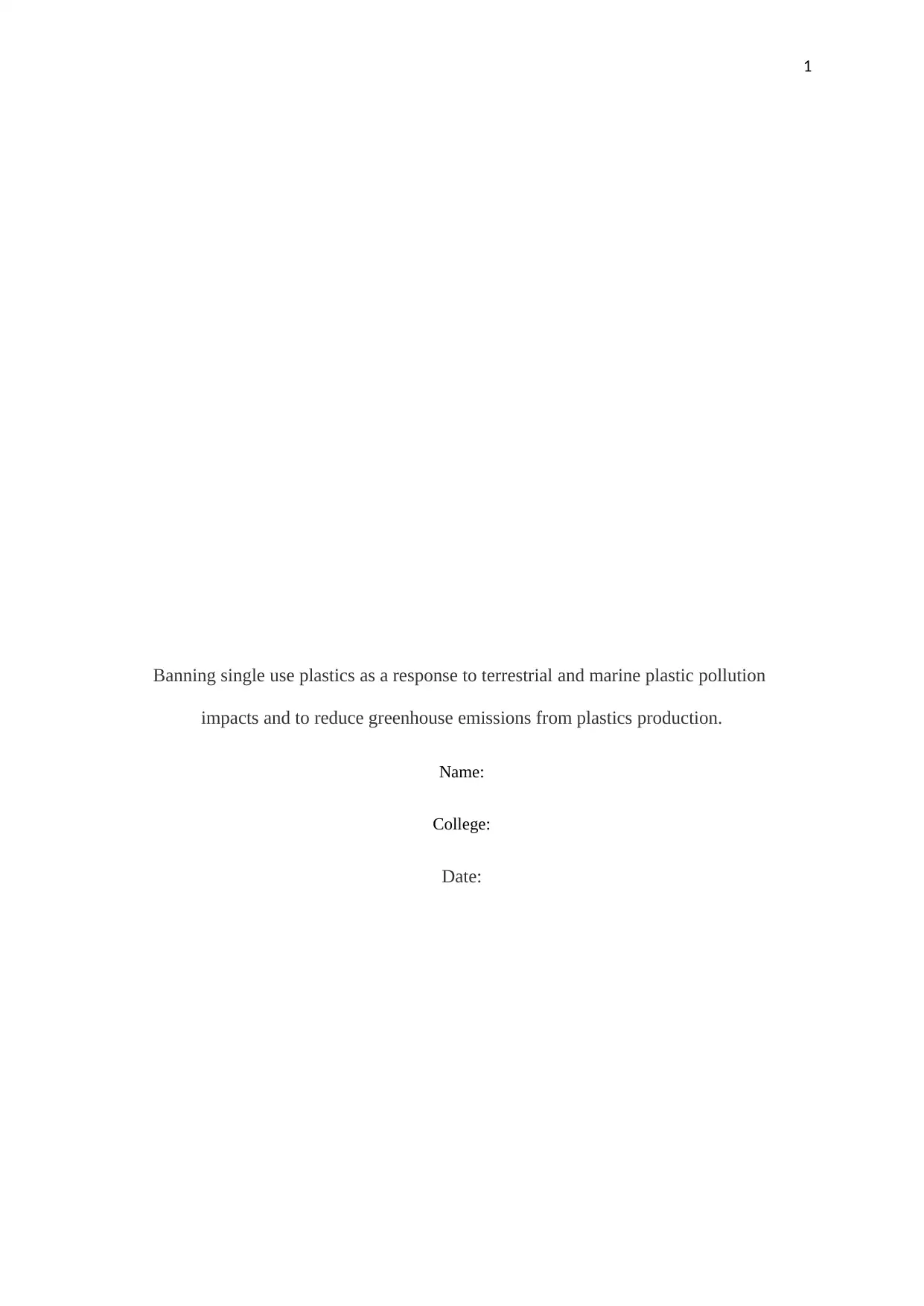
1
Banning single use plastics as a response to terrestrial and marine plastic pollution
impacts and to reduce greenhouse emissions from plastics production.
Name:
College:
Date:
Banning single use plastics as a response to terrestrial and marine plastic pollution
impacts and to reduce greenhouse emissions from plastics production.
Name:
College:
Date:
Secure Best Marks with AI Grader
Need help grading? Try our AI Grader for instant feedback on your assignments.
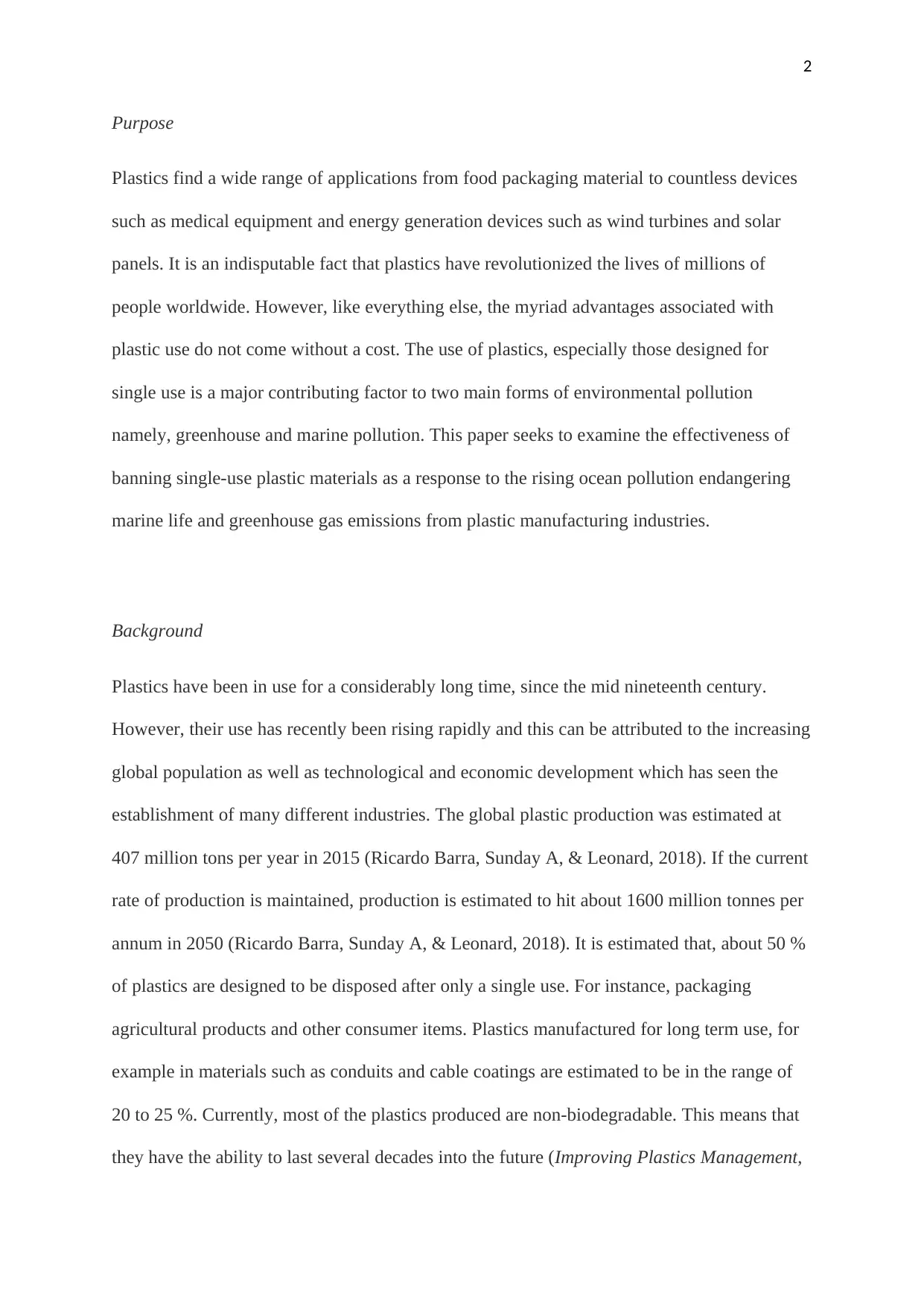
2
Purpose
Plastics find a wide range of applications from food packaging material to countless devices
such as medical equipment and energy generation devices such as wind turbines and solar
panels. It is an indisputable fact that plastics have revolutionized the lives of millions of
people worldwide. However, like everything else, the myriad advantages associated with
plastic use do not come without a cost. The use of plastics, especially those designed for
single use is a major contributing factor to two main forms of environmental pollution
namely, greenhouse and marine pollution. This paper seeks to examine the effectiveness of
banning single-use plastic materials as a response to the rising ocean pollution endangering
marine life and greenhouse gas emissions from plastic manufacturing industries.
Background
Plastics have been in use for a considerably long time, since the mid nineteenth century.
However, their use has recently been rising rapidly and this can be attributed to the increasing
global population as well as technological and economic development which has seen the
establishment of many different industries. The global plastic production was estimated at
407 million tons per year in 2015 (Ricardo Barra, Sunday A, & Leonard, 2018). If the current
rate of production is maintained, production is estimated to hit about 1600 million tonnes per
annum in 2050 (Ricardo Barra, Sunday A, & Leonard, 2018). It is estimated that, about 50 %
of plastics are designed to be disposed after only a single use. For instance, packaging
agricultural products and other consumer items. Plastics manufactured for long term use, for
example in materials such as conduits and cable coatings are estimated to be in the range of
20 to 25 %. Currently, most of the plastics produced are non-biodegradable. This means that
they have the ability to last several decades into the future (Improving Plastics Management,
Purpose
Plastics find a wide range of applications from food packaging material to countless devices
such as medical equipment and energy generation devices such as wind turbines and solar
panels. It is an indisputable fact that plastics have revolutionized the lives of millions of
people worldwide. However, like everything else, the myriad advantages associated with
plastic use do not come without a cost. The use of plastics, especially those designed for
single use is a major contributing factor to two main forms of environmental pollution
namely, greenhouse and marine pollution. This paper seeks to examine the effectiveness of
banning single-use plastic materials as a response to the rising ocean pollution endangering
marine life and greenhouse gas emissions from plastic manufacturing industries.
Background
Plastics have been in use for a considerably long time, since the mid nineteenth century.
However, their use has recently been rising rapidly and this can be attributed to the increasing
global population as well as technological and economic development which has seen the
establishment of many different industries. The global plastic production was estimated at
407 million tons per year in 2015 (Ricardo Barra, Sunday A, & Leonard, 2018). If the current
rate of production is maintained, production is estimated to hit about 1600 million tonnes per
annum in 2050 (Ricardo Barra, Sunday A, & Leonard, 2018). It is estimated that, about 50 %
of plastics are designed to be disposed after only a single use. For instance, packaging
agricultural products and other consumer items. Plastics manufactured for long term use, for
example in materials such as conduits and cable coatings are estimated to be in the range of
20 to 25 %. Currently, most of the plastics produced are non-biodegradable. This means that
they have the ability to last several decades into the future (Improving Plastics Management,
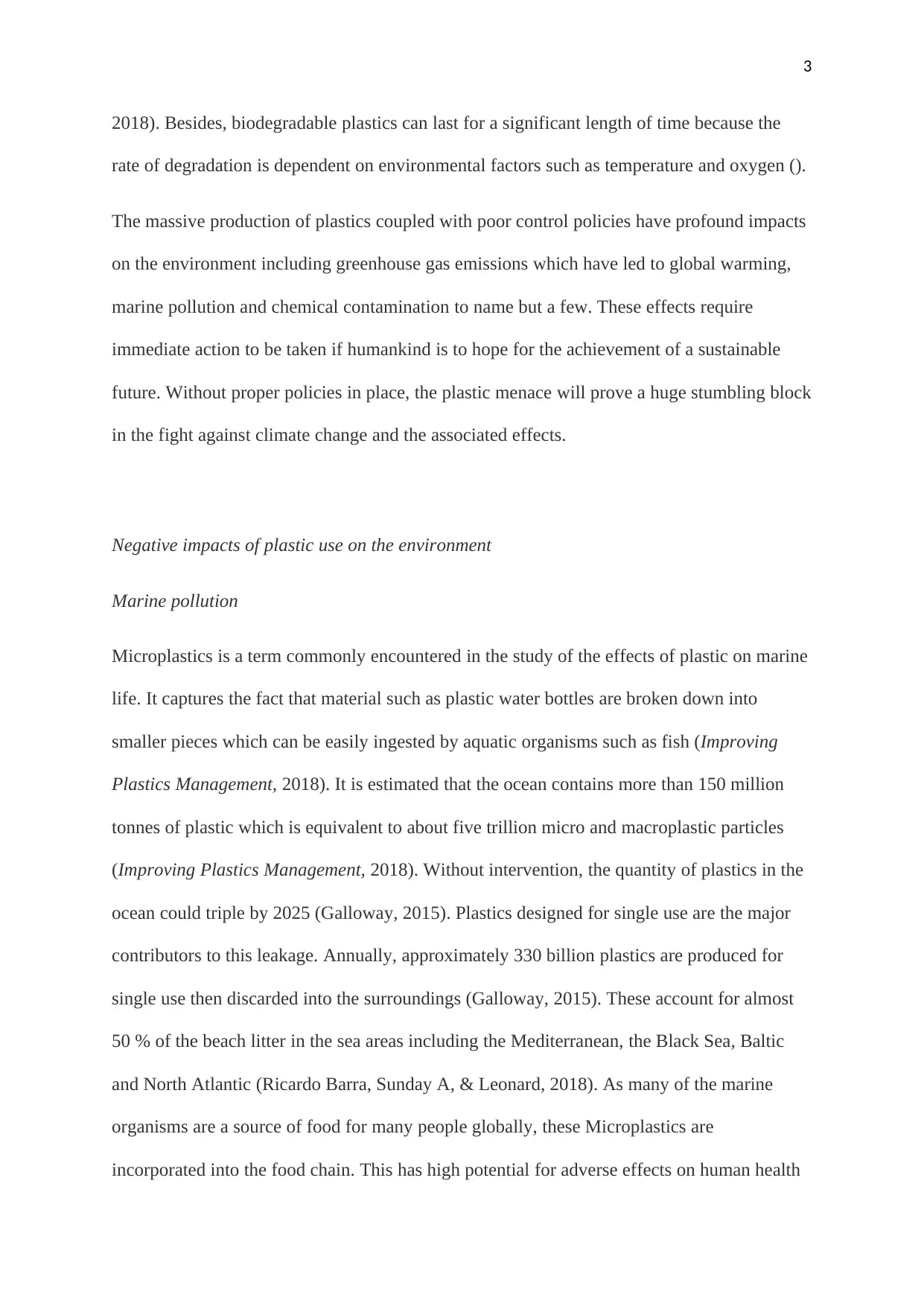
3
2018). Besides, biodegradable plastics can last for a significant length of time because the
rate of degradation is dependent on environmental factors such as temperature and oxygen ().
The massive production of plastics coupled with poor control policies have profound impacts
on the environment including greenhouse gas emissions which have led to global warming,
marine pollution and chemical contamination to name but a few. These effects require
immediate action to be taken if humankind is to hope for the achievement of a sustainable
future. Without proper policies in place, the plastic menace will prove a huge stumbling block
in the fight against climate change and the associated effects.
Negative impacts of plastic use on the environment
Marine pollution
Microplastics is a term commonly encountered in the study of the effects of plastic on marine
life. It captures the fact that material such as plastic water bottles are broken down into
smaller pieces which can be easily ingested by aquatic organisms such as fish (Improving
Plastics Management, 2018). It is estimated that the ocean contains more than 150 million
tonnes of plastic which is equivalent to about five trillion micro and macroplastic particles
(Improving Plastics Management, 2018). Without intervention, the quantity of plastics in the
ocean could triple by 2025 (Galloway, 2015). Plastics designed for single use are the major
contributors to this leakage. Annually, approximately 330 billion plastics are produced for
single use then discarded into the surroundings (Galloway, 2015). These account for almost
50 % of the beach litter in the sea areas including the Mediterranean, the Black Sea, Baltic
and North Atlantic (Ricardo Barra, Sunday A, & Leonard, 2018). As many of the marine
organisms are a source of food for many people globally, these Microplastics are
incorporated into the food chain. This has high potential for adverse effects on human health
2018). Besides, biodegradable plastics can last for a significant length of time because the
rate of degradation is dependent on environmental factors such as temperature and oxygen ().
The massive production of plastics coupled with poor control policies have profound impacts
on the environment including greenhouse gas emissions which have led to global warming,
marine pollution and chemical contamination to name but a few. These effects require
immediate action to be taken if humankind is to hope for the achievement of a sustainable
future. Without proper policies in place, the plastic menace will prove a huge stumbling block
in the fight against climate change and the associated effects.
Negative impacts of plastic use on the environment
Marine pollution
Microplastics is a term commonly encountered in the study of the effects of plastic on marine
life. It captures the fact that material such as plastic water bottles are broken down into
smaller pieces which can be easily ingested by aquatic organisms such as fish (Improving
Plastics Management, 2018). It is estimated that the ocean contains more than 150 million
tonnes of plastic which is equivalent to about five trillion micro and macroplastic particles
(Improving Plastics Management, 2018). Without intervention, the quantity of plastics in the
ocean could triple by 2025 (Galloway, 2015). Plastics designed for single use are the major
contributors to this leakage. Annually, approximately 330 billion plastics are produced for
single use then discarded into the surroundings (Galloway, 2015). These account for almost
50 % of the beach litter in the sea areas including the Mediterranean, the Black Sea, Baltic
and North Atlantic (Ricardo Barra, Sunday A, & Leonard, 2018). As many of the marine
organisms are a source of food for many people globally, these Microplastics are
incorporated into the food chain. This has high potential for adverse effects on human health
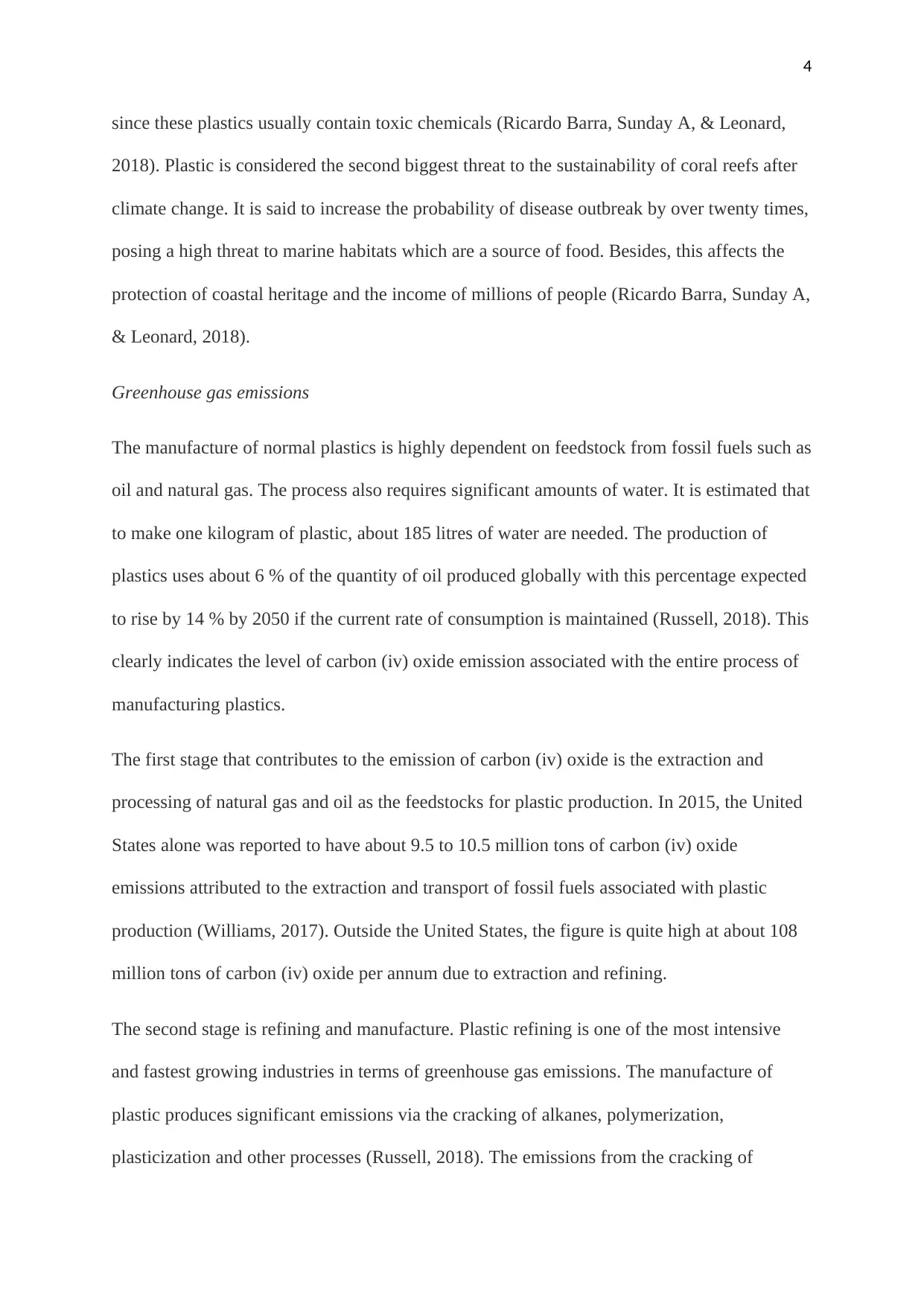
4
since these plastics usually contain toxic chemicals (Ricardo Barra, Sunday A, & Leonard,
2018). Plastic is considered the second biggest threat to the sustainability of coral reefs after
climate change. It is said to increase the probability of disease outbreak by over twenty times,
posing a high threat to marine habitats which are a source of food. Besides, this affects the
protection of coastal heritage and the income of millions of people (Ricardo Barra, Sunday A,
& Leonard, 2018).
Greenhouse gas emissions
The manufacture of normal plastics is highly dependent on feedstock from fossil fuels such as
oil and natural gas. The process also requires significant amounts of water. It is estimated that
to make one kilogram of plastic, about 185 litres of water are needed. The production of
plastics uses about 6 % of the quantity of oil produced globally with this percentage expected
to rise by 14 % by 2050 if the current rate of consumption is maintained (Russell, 2018). This
clearly indicates the level of carbon (iv) oxide emission associated with the entire process of
manufacturing plastics.
The first stage that contributes to the emission of carbon (iv) oxide is the extraction and
processing of natural gas and oil as the feedstocks for plastic production. In 2015, the United
States alone was reported to have about 9.5 to 10.5 million tons of carbon (iv) oxide
emissions attributed to the extraction and transport of fossil fuels associated with plastic
production (Williams, 2017). Outside the United States, the figure is quite high at about 108
million tons of carbon (iv) oxide per annum due to extraction and refining.
The second stage is refining and manufacture. Plastic refining is one of the most intensive
and fastest growing industries in terms of greenhouse gas emissions. The manufacture of
plastic produces significant emissions via the cracking of alkanes, polymerization,
plasticization and other processes (Russell, 2018). The emissions from the cracking of
since these plastics usually contain toxic chemicals (Ricardo Barra, Sunday A, & Leonard,
2018). Plastic is considered the second biggest threat to the sustainability of coral reefs after
climate change. It is said to increase the probability of disease outbreak by over twenty times,
posing a high threat to marine habitats which are a source of food. Besides, this affects the
protection of coastal heritage and the income of millions of people (Ricardo Barra, Sunday A,
& Leonard, 2018).
Greenhouse gas emissions
The manufacture of normal plastics is highly dependent on feedstock from fossil fuels such as
oil and natural gas. The process also requires significant amounts of water. It is estimated that
to make one kilogram of plastic, about 185 litres of water are needed. The production of
plastics uses about 6 % of the quantity of oil produced globally with this percentage expected
to rise by 14 % by 2050 if the current rate of consumption is maintained (Russell, 2018). This
clearly indicates the level of carbon (iv) oxide emission associated with the entire process of
manufacturing plastics.
The first stage that contributes to the emission of carbon (iv) oxide is the extraction and
processing of natural gas and oil as the feedstocks for plastic production. In 2015, the United
States alone was reported to have about 9.5 to 10.5 million tons of carbon (iv) oxide
emissions attributed to the extraction and transport of fossil fuels associated with plastic
production (Williams, 2017). Outside the United States, the figure is quite high at about 108
million tons of carbon (iv) oxide per annum due to extraction and refining.
The second stage is refining and manufacture. Plastic refining is one of the most intensive
and fastest growing industries in terms of greenhouse gas emissions. The manufacture of
plastic produces significant emissions via the cracking of alkanes, polymerization,
plasticization and other processes (Russell, 2018). The emissions from the cracking of
Secure Best Marks with AI Grader
Need help grading? Try our AI Grader for instant feedback on your assignments.
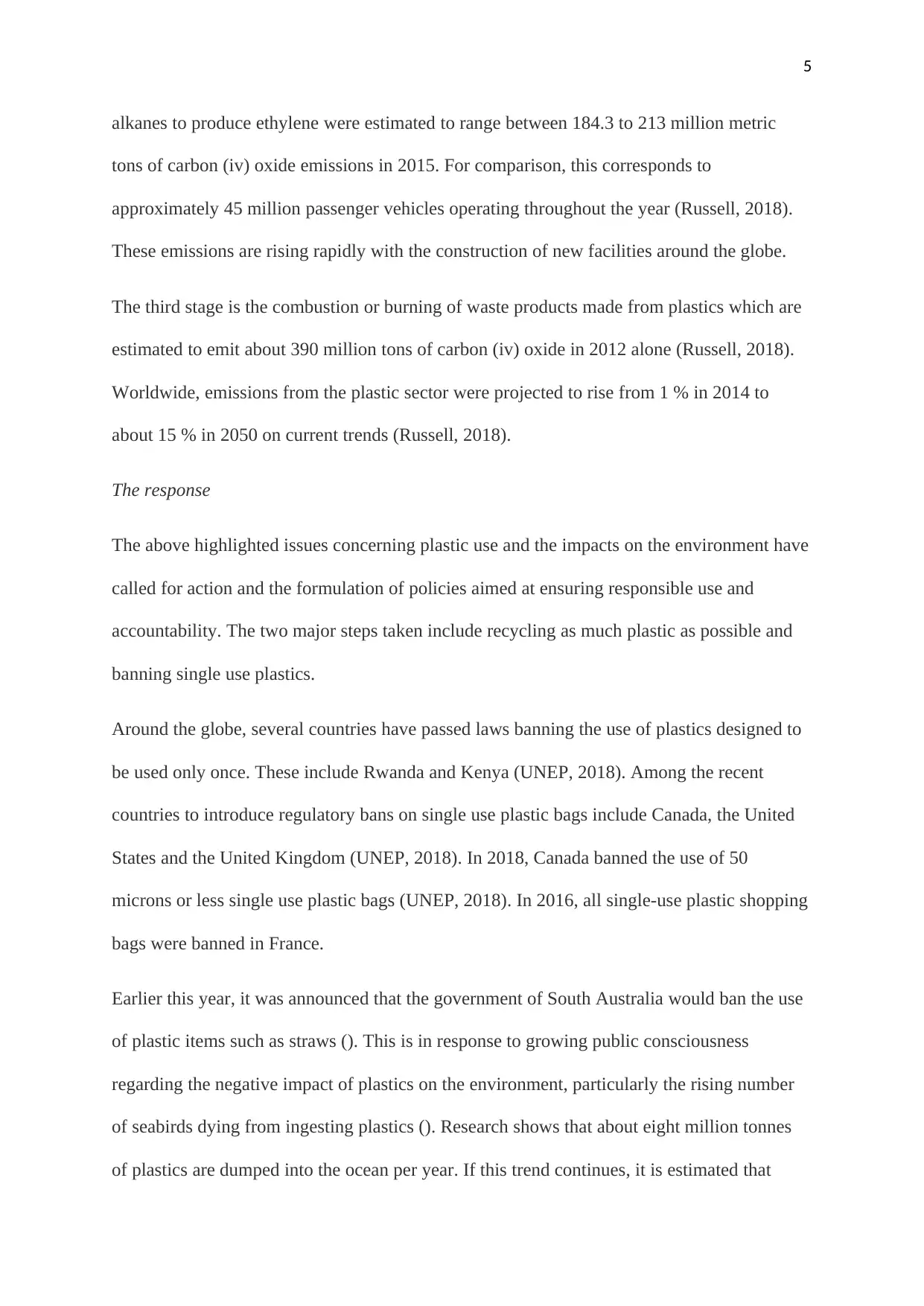
5
alkanes to produce ethylene were estimated to range between 184.3 to 213 million metric
tons of carbon (iv) oxide emissions in 2015. For comparison, this corresponds to
approximately 45 million passenger vehicles operating throughout the year (Russell, 2018).
These emissions are rising rapidly with the construction of new facilities around the globe.
The third stage is the combustion or burning of waste products made from plastics which are
estimated to emit about 390 million tons of carbon (iv) oxide in 2012 alone (Russell, 2018).
Worldwide, emissions from the plastic sector were projected to rise from 1 % in 2014 to
about 15 % in 2050 on current trends (Russell, 2018).
The response
The above highlighted issues concerning plastic use and the impacts on the environment have
called for action and the formulation of policies aimed at ensuring responsible use and
accountability. The two major steps taken include recycling as much plastic as possible and
banning single use plastics.
Around the globe, several countries have passed laws banning the use of plastics designed to
be used only once. These include Rwanda and Kenya (UNEP, 2018). Among the recent
countries to introduce regulatory bans on single use plastic bags include Canada, the United
States and the United Kingdom (UNEP, 2018). In 2018, Canada banned the use of 50
microns or less single use plastic bags (UNEP, 2018). In 2016, all single-use plastic shopping
bags were banned in France.
Earlier this year, it was announced that the government of South Australia would ban the use
of plastic items such as straws (). This is in response to growing public consciousness
regarding the negative impact of plastics on the environment, particularly the rising number
of seabirds dying from ingesting plastics (). Research shows that about eight million tonnes
of plastics are dumped into the ocean per year. If this trend continues, it is estimated that
alkanes to produce ethylene were estimated to range between 184.3 to 213 million metric
tons of carbon (iv) oxide emissions in 2015. For comparison, this corresponds to
approximately 45 million passenger vehicles operating throughout the year (Russell, 2018).
These emissions are rising rapidly with the construction of new facilities around the globe.
The third stage is the combustion or burning of waste products made from plastics which are
estimated to emit about 390 million tons of carbon (iv) oxide in 2012 alone (Russell, 2018).
Worldwide, emissions from the plastic sector were projected to rise from 1 % in 2014 to
about 15 % in 2050 on current trends (Russell, 2018).
The response
The above highlighted issues concerning plastic use and the impacts on the environment have
called for action and the formulation of policies aimed at ensuring responsible use and
accountability. The two major steps taken include recycling as much plastic as possible and
banning single use plastics.
Around the globe, several countries have passed laws banning the use of plastics designed to
be used only once. These include Rwanda and Kenya (UNEP, 2018). Among the recent
countries to introduce regulatory bans on single use plastic bags include Canada, the United
States and the United Kingdom (UNEP, 2018). In 2018, Canada banned the use of 50
microns or less single use plastic bags (UNEP, 2018). In 2016, all single-use plastic shopping
bags were banned in France.
Earlier this year, it was announced that the government of South Australia would ban the use
of plastic items such as straws (). This is in response to growing public consciousness
regarding the negative impact of plastics on the environment, particularly the rising number
of seabirds dying from ingesting plastics (). Research shows that about eight million tonnes
of plastics are dumped into the ocean per year. If this trend continues, it is estimated that
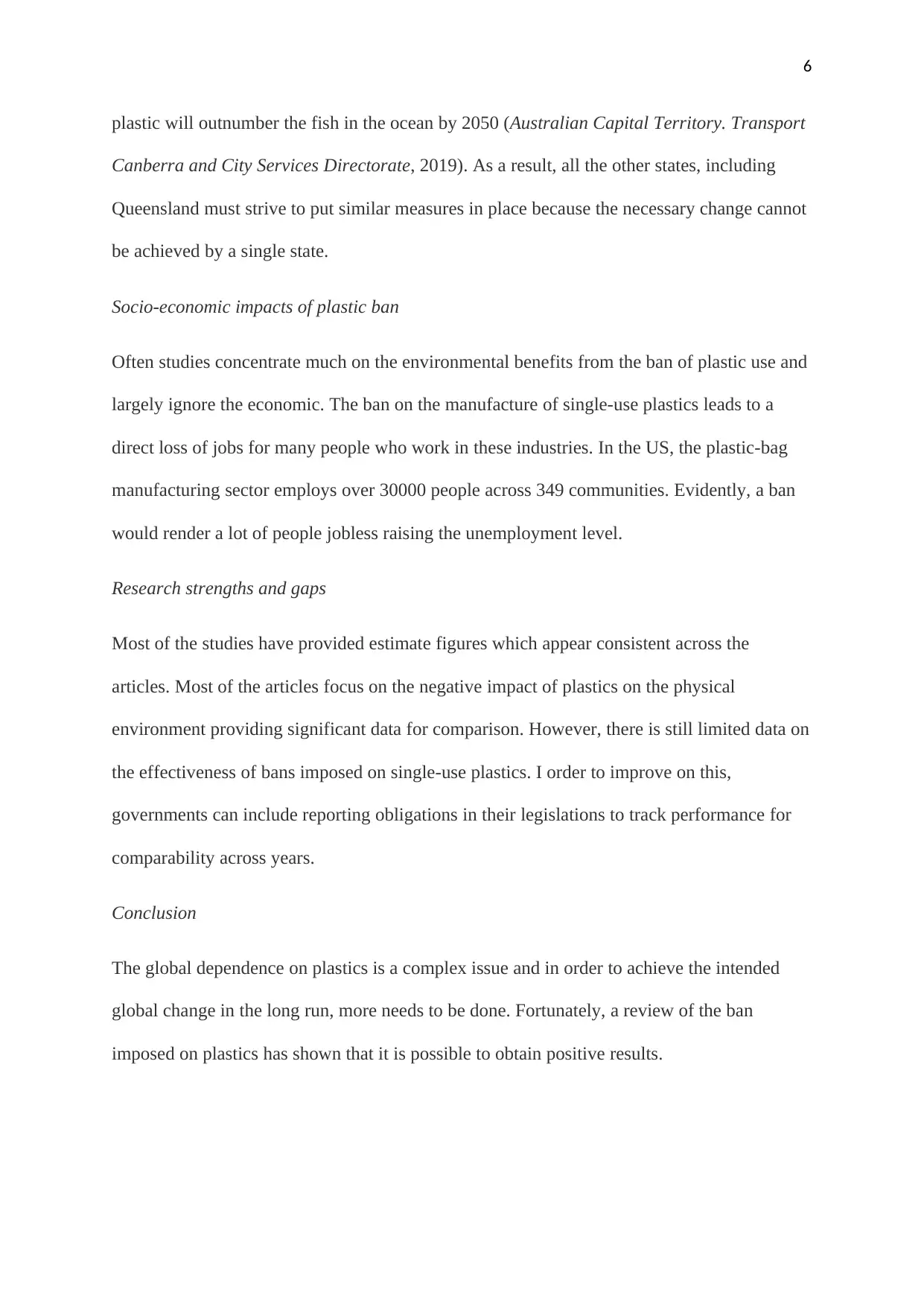
6
plastic will outnumber the fish in the ocean by 2050 (Australian Capital Territory. Transport
Canberra and City Services Directorate, 2019). As a result, all the other states, including
Queensland must strive to put similar measures in place because the necessary change cannot
be achieved by a single state.
Socio-economic impacts of plastic ban
Often studies concentrate much on the environmental benefits from the ban of plastic use and
largely ignore the economic. The ban on the manufacture of single-use plastics leads to a
direct loss of jobs for many people who work in these industries. In the US, the plastic-bag
manufacturing sector employs over 30000 people across 349 communities. Evidently, a ban
would render a lot of people jobless raising the unemployment level.
Research strengths and gaps
Most of the studies have provided estimate figures which appear consistent across the
articles. Most of the articles focus on the negative impact of plastics on the physical
environment providing significant data for comparison. However, there is still limited data on
the effectiveness of bans imposed on single-use plastics. I order to improve on this,
governments can include reporting obligations in their legislations to track performance for
comparability across years.
Conclusion
The global dependence on plastics is a complex issue and in order to achieve the intended
global change in the long run, more needs to be done. Fortunately, a review of the ban
imposed on plastics has shown that it is possible to obtain positive results.
plastic will outnumber the fish in the ocean by 2050 (Australian Capital Territory. Transport
Canberra and City Services Directorate, 2019). As a result, all the other states, including
Queensland must strive to put similar measures in place because the necessary change cannot
be achieved by a single state.
Socio-economic impacts of plastic ban
Often studies concentrate much on the environmental benefits from the ban of plastic use and
largely ignore the economic. The ban on the manufacture of single-use plastics leads to a
direct loss of jobs for many people who work in these industries. In the US, the plastic-bag
manufacturing sector employs over 30000 people across 349 communities. Evidently, a ban
would render a lot of people jobless raising the unemployment level.
Research strengths and gaps
Most of the studies have provided estimate figures which appear consistent across the
articles. Most of the articles focus on the negative impact of plastics on the physical
environment providing significant data for comparison. However, there is still limited data on
the effectiveness of bans imposed on single-use plastics. I order to improve on this,
governments can include reporting obligations in their legislations to track performance for
comparability across years.
Conclusion
The global dependence on plastics is a complex issue and in order to achieve the intended
global change in the long run, more needs to be done. Fortunately, a review of the ban
imposed on plastics has shown that it is possible to obtain positive results.
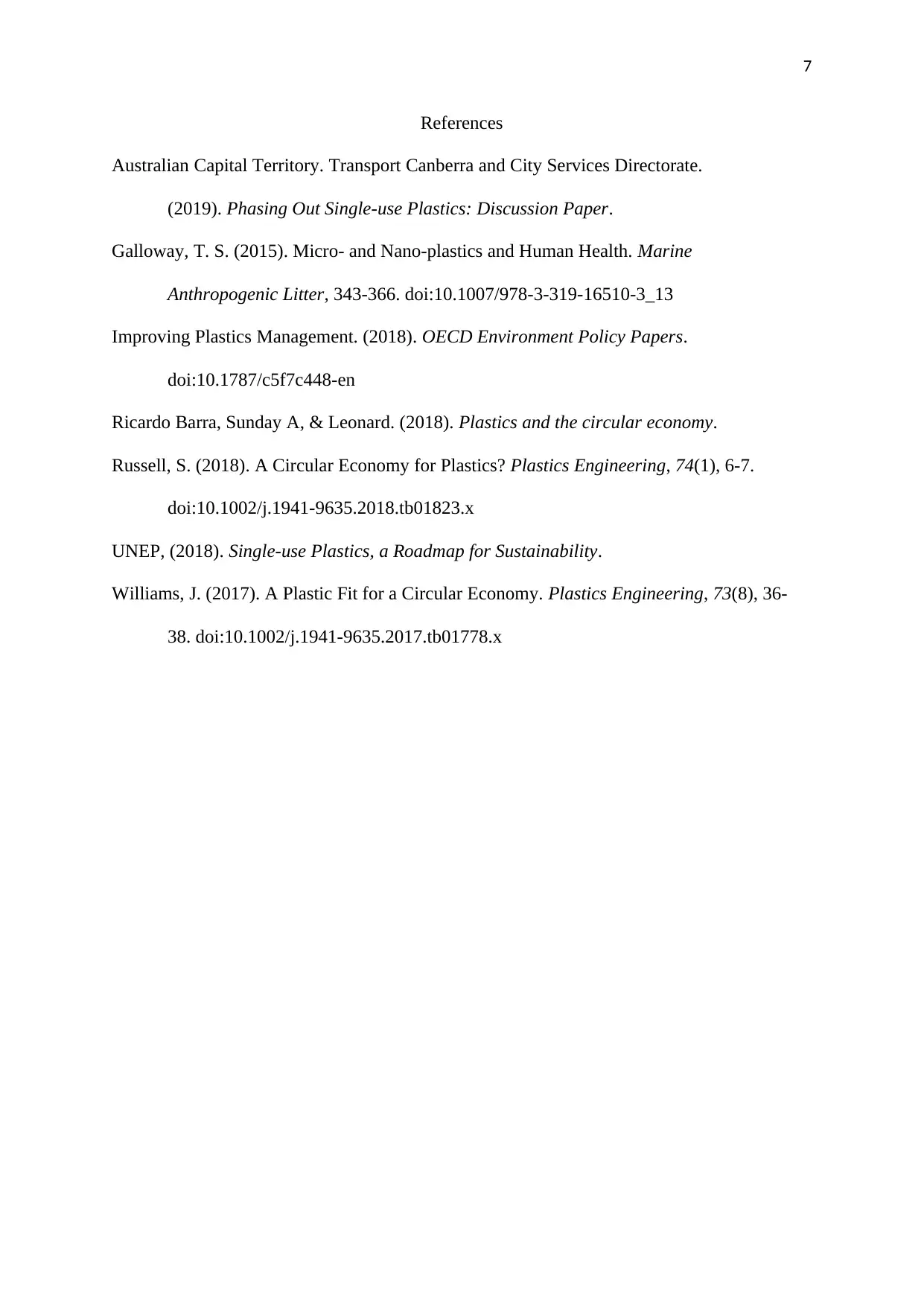
7
References
Australian Capital Territory. Transport Canberra and City Services Directorate.
(2019). Phasing Out Single-use Plastics: Discussion Paper.
Galloway, T. S. (2015). Micro- and Nano-plastics and Human Health. Marine
Anthropogenic Litter, 343-366. doi:10.1007/978-3-319-16510-3_13
Improving Plastics Management. (2018). OECD Environment Policy Papers.
doi:10.1787/c5f7c448-en
Ricardo Barra, Sunday A, & Leonard. (2018). Plastics and the circular economy.
Russell, S. (2018). A Circular Economy for Plastics? Plastics Engineering, 74(1), 6-7.
doi:10.1002/j.1941-9635.2018.tb01823.x
UNEP, (2018). Single-use Plastics, a Roadmap for Sustainability.
Williams, J. (2017). A Plastic Fit for a Circular Economy. Plastics Engineering, 73(8), 36-
38. doi:10.1002/j.1941-9635.2017.tb01778.x
References
Australian Capital Territory. Transport Canberra and City Services Directorate.
(2019). Phasing Out Single-use Plastics: Discussion Paper.
Galloway, T. S. (2015). Micro- and Nano-plastics and Human Health. Marine
Anthropogenic Litter, 343-366. doi:10.1007/978-3-319-16510-3_13
Improving Plastics Management. (2018). OECD Environment Policy Papers.
doi:10.1787/c5f7c448-en
Ricardo Barra, Sunday A, & Leonard. (2018). Plastics and the circular economy.
Russell, S. (2018). A Circular Economy for Plastics? Plastics Engineering, 74(1), 6-7.
doi:10.1002/j.1941-9635.2018.tb01823.x
UNEP, (2018). Single-use Plastics, a Roadmap for Sustainability.
Williams, J. (2017). A Plastic Fit for a Circular Economy. Plastics Engineering, 73(8), 36-
38. doi:10.1002/j.1941-9635.2017.tb01778.x
Paraphrase This Document
Need a fresh take? Get an instant paraphrase of this document with our AI Paraphraser
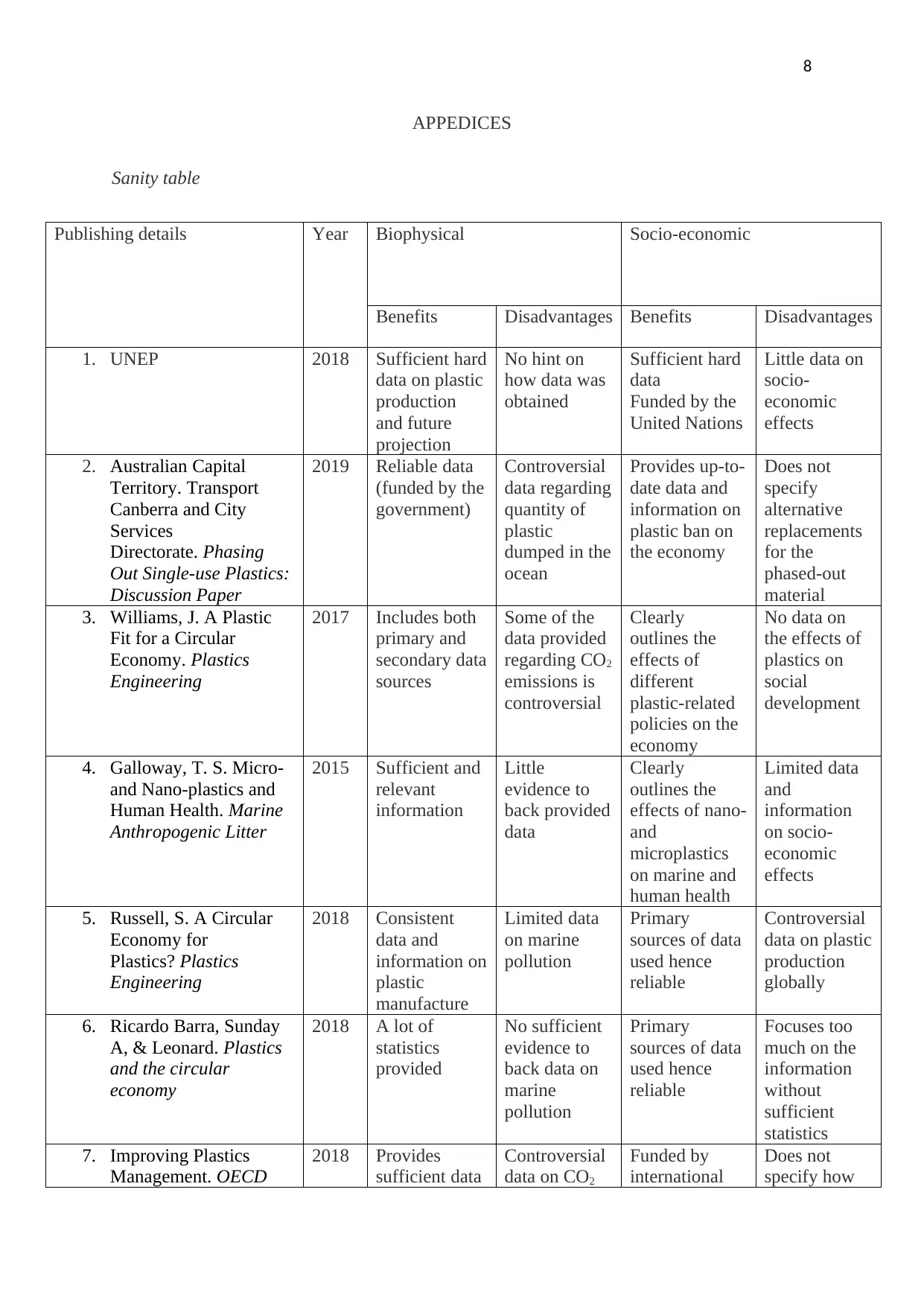
8
APPEDICES
Sanity table
Publishing details Year Biophysical Socio-economic
Benefits Disadvantages Benefits Disadvantages
1. UNEP 2018 Sufficient hard
data on plastic
production
and future
projection
No hint on
how data was
obtained
Sufficient hard
data
Funded by the
United Nations
Little data on
socio-
economic
effects
2. Australian Capital
Territory. Transport
Canberra and City
Services
Directorate. Phasing
Out Single-use Plastics:
Discussion Paper
2019 Reliable data
(funded by the
government)
Controversial
data regarding
quantity of
plastic
dumped in the
ocean
Provides up-to-
date data and
information on
plastic ban on
the economy
Does not
specify
alternative
replacements
for the
phased-out
material
3. Williams, J. A Plastic
Fit for a Circular
Economy. Plastics
Engineering
2017 Includes both
primary and
secondary data
sources
Some of the
data provided
regarding CO2
emissions is
controversial
Clearly
outlines the
effects of
different
plastic-related
policies on the
economy
No data on
the effects of
plastics on
social
development
4. Galloway, T. S. Micro-
and Nano-plastics and
Human Health. Marine
Anthropogenic Litter
2015 Sufficient and
relevant
information
Little
evidence to
back provided
data
Clearly
outlines the
effects of nano-
and
microplastics
on marine and
human health
Limited data
and
information
on socio-
economic
effects
5. Russell, S. A Circular
Economy for
Plastics? Plastics
Engineering
2018 Consistent
data and
information on
plastic
manufacture
Limited data
on marine
pollution
Primary
sources of data
used hence
reliable
Controversial
data on plastic
production
globally
6. Ricardo Barra, Sunday
A, & Leonard. Plastics
and the circular
economy
2018 A lot of
statistics
provided
No sufficient
evidence to
back data on
marine
pollution
Primary
sources of data
used hence
reliable
Focuses too
much on the
information
without
sufficient
statistics
7. Improving Plastics
Management. OECD
2018 Provides
sufficient data
Controversial
data on CO2
Funded by
international
Does not
specify how
APPEDICES
Sanity table
Publishing details Year Biophysical Socio-economic
Benefits Disadvantages Benefits Disadvantages
1. UNEP 2018 Sufficient hard
data on plastic
production
and future
projection
No hint on
how data was
obtained
Sufficient hard
data
Funded by the
United Nations
Little data on
socio-
economic
effects
2. Australian Capital
Territory. Transport
Canberra and City
Services
Directorate. Phasing
Out Single-use Plastics:
Discussion Paper
2019 Reliable data
(funded by the
government)
Controversial
data regarding
quantity of
plastic
dumped in the
ocean
Provides up-to-
date data and
information on
plastic ban on
the economy
Does not
specify
alternative
replacements
for the
phased-out
material
3. Williams, J. A Plastic
Fit for a Circular
Economy. Plastics
Engineering
2017 Includes both
primary and
secondary data
sources
Some of the
data provided
regarding CO2
emissions is
controversial
Clearly
outlines the
effects of
different
plastic-related
policies on the
economy
No data on
the effects of
plastics on
social
development
4. Galloway, T. S. Micro-
and Nano-plastics and
Human Health. Marine
Anthropogenic Litter
2015 Sufficient and
relevant
information
Little
evidence to
back provided
data
Clearly
outlines the
effects of nano-
and
microplastics
on marine and
human health
Limited data
and
information
on socio-
economic
effects
5. Russell, S. A Circular
Economy for
Plastics? Plastics
Engineering
2018 Consistent
data and
information on
plastic
manufacture
Limited data
on marine
pollution
Primary
sources of data
used hence
reliable
Controversial
data on plastic
production
globally
6. Ricardo Barra, Sunday
A, & Leonard. Plastics
and the circular
economy
2018 A lot of
statistics
provided
No sufficient
evidence to
back data on
marine
pollution
Primary
sources of data
used hence
reliable
Focuses too
much on the
information
without
sufficient
statistics
7. Improving Plastics
Management. OECD
2018 Provides
sufficient data
Controversial
data on CO2
Funded by
international
Does not
specify how
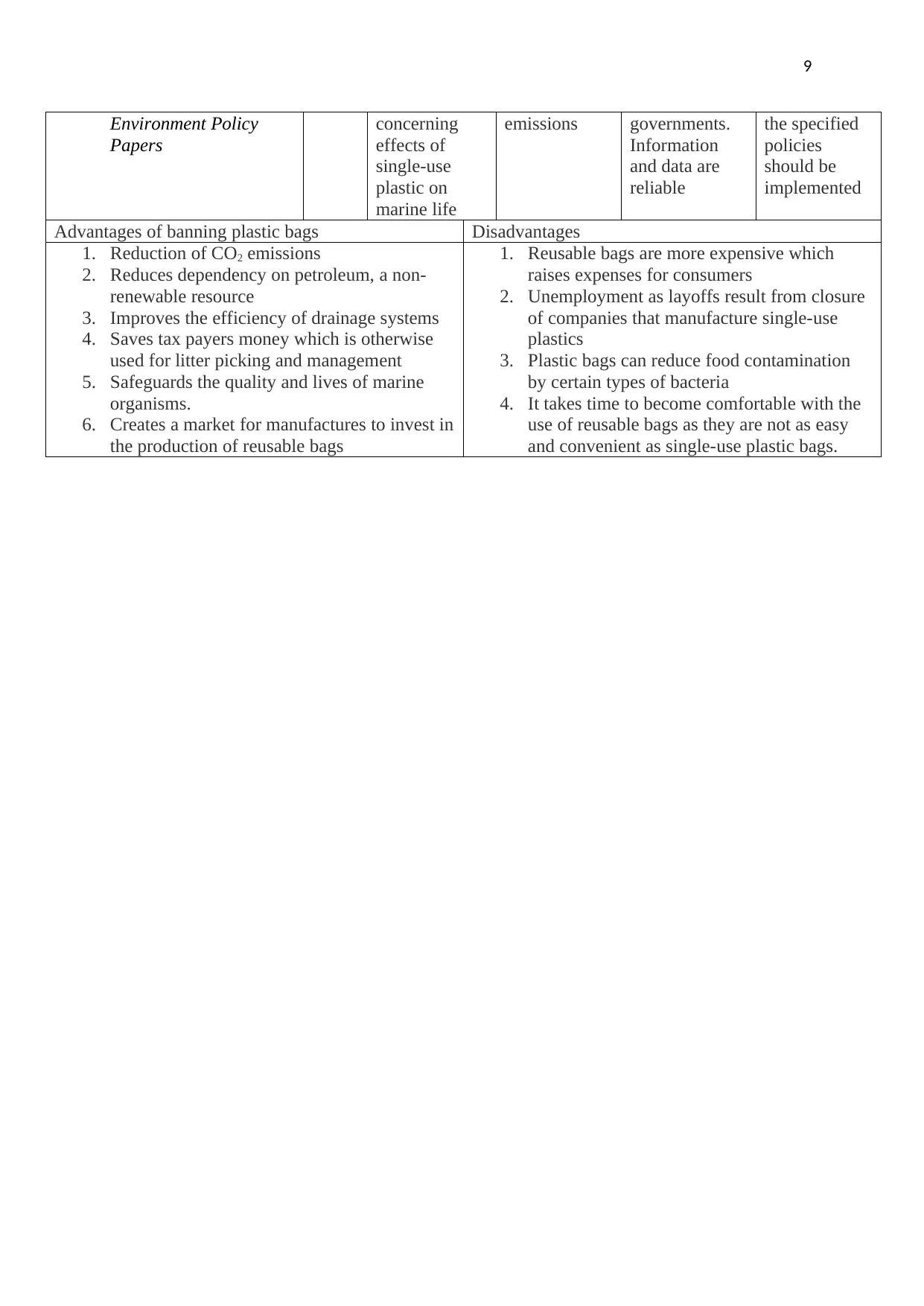
9
Environment Policy
Papers
concerning
effects of
single-use
plastic on
marine life
emissions governments.
Information
and data are
reliable
the specified
policies
should be
implemented
Advantages of banning plastic bags Disadvantages
1. Reduction of CO2 emissions
2. Reduces dependency on petroleum, a non-
renewable resource
3. Improves the efficiency of drainage systems
4. Saves tax payers money which is otherwise
used for litter picking and management
5. Safeguards the quality and lives of marine
organisms.
6. Creates a market for manufactures to invest in
the production of reusable bags
1. Reusable bags are more expensive which
raises expenses for consumers
2. Unemployment as layoffs result from closure
of companies that manufacture single-use
plastics
3. Plastic bags can reduce food contamination
by certain types of bacteria
4. It takes time to become comfortable with the
use of reusable bags as they are not as easy
and convenient as single-use plastic bags.
Environment Policy
Papers
concerning
effects of
single-use
plastic on
marine life
emissions governments.
Information
and data are
reliable
the specified
policies
should be
implemented
Advantages of banning plastic bags Disadvantages
1. Reduction of CO2 emissions
2. Reduces dependency on petroleum, a non-
renewable resource
3. Improves the efficiency of drainage systems
4. Saves tax payers money which is otherwise
used for litter picking and management
5. Safeguards the quality and lives of marine
organisms.
6. Creates a market for manufactures to invest in
the production of reusable bags
1. Reusable bags are more expensive which
raises expenses for consumers
2. Unemployment as layoffs result from closure
of companies that manufacture single-use
plastics
3. Plastic bags can reduce food contamination
by certain types of bacteria
4. It takes time to become comfortable with the
use of reusable bags as they are not as easy
and convenient as single-use plastic bags.
1 out of 9
Related Documents
Your All-in-One AI-Powered Toolkit for Academic Success.
+13062052269
info@desklib.com
Available 24*7 on WhatsApp / Email
![[object Object]](/_next/static/media/star-bottom.7253800d.svg)
Unlock your academic potential
© 2024 | Zucol Services PVT LTD | All rights reserved.





